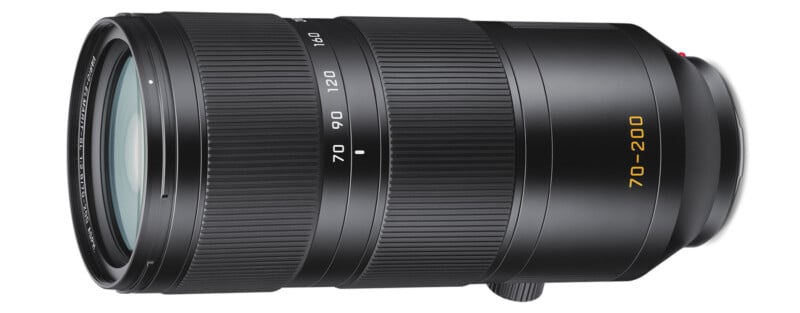![]()
Leica announced the Vario-Elmarit-SL 70-200mm f/2.8 ASPH, the final lens in Leica’s trio of f/2.8 professional zooms for the full-frame SL-System.
Joining the Leica Super-Vario-Elmarit-SL 14-24mm f/2.8 ASPH and Vario-Elmarit-SL 24-70mm f/2.8 ASPH, the new 70-200mm f/2.8 lens significantly expands the focal length coverage of Leica’s SL-System lenses. Further, Leica Camera AG also introduced the Extender L 2.0x teleconverter, further increasing the versatility of its SL lenses and turning the new 70-200mm lens into a 140-400mm f/4 zoom.
 Leica Vario-Elmarit-SL 70-200mm f/2.8 ASPH
Leica Vario-Elmarit-SL 70-200mm f/2.8 ASPHLeica says the 70-200mm f/2.8 is “ideally suited” to portraiture, event, sports, and nature photography. The lens includes 20 elements arranged across 15 groups, including a trio of aspherical elements.
Photographers tuned into Sigma’s lens offerings may find the optical design strikingly familiar, as Sigma’s 70-200mm f/2.8 DG DN OS Sports lens released last year for E- and L-Mount cameras also sports 20 elements in 15 groups, including three aspherical elements. The Leica and Sigma lenses also share other features in common, including their maximum reproduction ratios of just over 1:5 and 11-bladed aperture diaphragms.
 Despite some differences in how Leica and Sigma show their lens designs, including different focus group positioning, the overlap in the two 70-200mm f/2.8 lenses is obvious. The Leica is on the left, while Sigma’s lens is on the right. | Credit: Leica / Sigma
Despite some differences in how Leica and Sigma show their lens designs, including different focus group positioning, the overlap in the two 70-200mm f/2.8 lenses is obvious. The Leica is on the left, while Sigma’s lens is on the right. | Credit: Leica / SigmaThe Leica Vario-Elmarit-SL 70-200mm f/2.8 promises high performance for still photography and video applications. The lens features an internal focusing design, meaning its physical length doesn’t change when adjusting the focal length or focus distance. Leica also promises razor-sharp images across the entire image frame, corner-to-corner, at all focal lengths.
The Vario-Elmarit-SL 70-200mm zoom weighs 1,540 grams (3.4 pounds) without its lens hood, about 200 grams heavier than the Sigma 70-200mm f/2.8, which weighs 1,345 grams (three pounds). The two L-Mount f/2.8 zooms are practically the same length — about 205 millimeters (8.1 inches).
 Leica’s three f/2.8 SL zoom lenses
Leica’s three f/2.8 SL zoom lensesLeica’s new zoom lens sports Leica’s familiar, simple SL aesthetic, including the typical Leica font and dial textures. The magnesium and aluminum barrel has engraved focal length markings at 70, 90, 120, 160, and 200mm focal lengths and includes a detachable tripod shoe. The lens is dust and splash-resistant and includes Hydrophobe Aqua-Dura coating on exposed elements.
The lens differs quite a bit in its appearance from Sigma’s 70-200mm f/2.8 DG DN OS Sports lens, which includes more text, a manual aperture control ring, and numerous buttons and dials. Leica’s lens has no aperture ring, buttons, or switches. Functions are controlled via the camera, including swapping between automatic and manual focusing and adjusting the electronic aperture.
 Leica Vario-Elmarit-SL 70-200mm f/2.8, Leica’s new 2x teleconverter, and the Leica SL3
Leica Vario-Elmarit-SL 70-200mm f/2.8, Leica’s new 2x teleconverter, and the Leica SL3While these differences are rather significant, none is larger than the price gap between the lenses. There are now three 70-200mm f/2.8 telephoto zooms available for L-Mount cameras, the Sigma 70-200mm f/2.8 DG DN OS Sports, the Panasonic Lumix S Pro 70-200mm f/2.8 OIS, and now the Leica Vario-Elmarit-SL 70-200mm f/2.8 ASPH. The Sigma is the most affordable of the three options at $1,499. Panasonic’s lens is available for $1,998, down from its MSRP of $2,298. The Leica lens is considerably pricier, setting photographers back $3,295.
![]()
The Leica Extender L 2.0x is also relatively expensive, costing $995. Sigma’s TC-2011 2x Teleconverter for Leica L is $429, and Panasonic’s DMW-STC20 Lumix S 2x Teleconverter is $598. By the way, like Sigma’s 2x teleconverter, Leica’s new one has eight elements in eight groups. However, Leica didn’t provide the optical diagram for the teleconverter, so it’s impossible to know if this is just a coincidence.
Both the new Leica 70-200mm f/2.8 and accompanying teleconverter are available globally now and, despite their relatively high prices, are poised to deliver high-quality performance while oozing Leica style.
Image credits: Leica


/cdn.vox-cdn.com/uploads/chorus_asset/file/24371439/236492_MacBook_Pro_16__2023__AKrales_0247.jpg)

:quality(85):upscale()/2024/09/09/791/n/49351773/91e1c31e66df37933d9bf8.44427956_.jpg)

 English (US) ·
English (US) ·